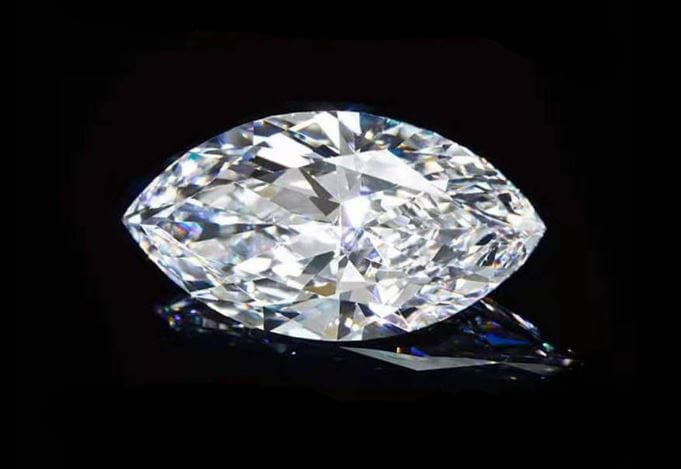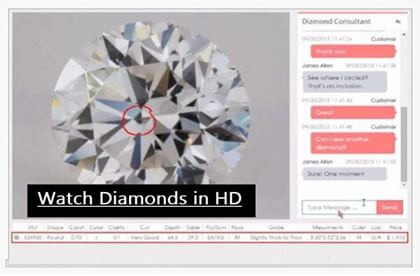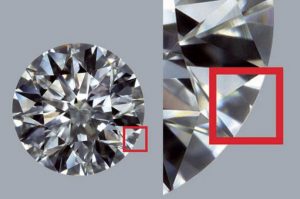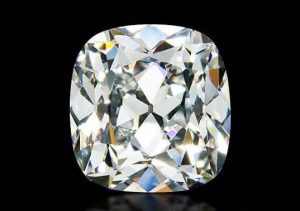The marquise cut diamond is a brilliant-cut. This cut features an elongated shape with pointed ends like a football/curved shape. The marquise diamond cut got its name after Marquise of Pompadour in the 18th century when the French Monarchy, King Louis XIV of France had asked for a diamond cut that perfectly looks like his mistress ‘lips. This brilliant-cut is also known as “Navette” shape, which means “little ship” in French as the shape of the cut is said to mirror the hull of a small boat- fuller at the middle and narrower towards the end.
This brilliant-cut has features that are similar to the oval diamond cut. An illusion of greater size is usually created by the long and narrow shape of the marquise cut diamond that seems to be greater in size than other shapes with similar carat weight.
In the 1400s, diamonds were popular gemstones only made for royal people. This cut is one of the several types of cuts that have been developed over the years. Marquise cut diamond is more popular in engagement because of its history.
Analysis of the Marquise Cut
The marquise cut is known to have 58 facets with 25 on the pavilion and 33 on the crown, although the number of pavilions may be between 4 and 8. The length to width ratio is an important aspect to consider. A typical marquise cut diamond will have a length to width ratio of 1.75, 1.95, or 2.15. Symmetry is also an essential part to consider in the marquise cut diamond. People will think that it is an oval cut if a marquise cut is too small, but if it’s too long then it will affect the overall brilliance. The symmetry is an essential consideration in figuring out the overall visual appeal of the marquise cut diamond. The symmetry of a diamond is evaluated by GIA based on visual observations. GIA diamond grading reports provide an assessment of symmetry based on a five-point scale ranging between Excellent to Poor. Here are some simple pointers you can use when evaluating the symmetry of a marquise cut diamond;
Check the curve of the wings to make sure they are symmetrical. Ensure all the wings should have the same amount of curve.
Draw a horizontal line that is imaginary across the diamond at the belly and observe if the two halves are symmetrical in outline and also equal in length. Ensure one half of the diamond should not be shorter or longer than the other half.
The symmetry of the facets also helps to figure the beauty of the cut. Then draw an imaginary line down the length of the diamond: The facets on the right and left halves should be of the same shape and size and should be at the same relative locations along with the wings. Draw an imaginary horizontal line over the diamond, and check if the facets on the top and bottom halves are also symmetrical. Note that the more symmetrical the facets are, the more appealing the diamond will be.
Look for any extra or missing facets.
The shape of the stone makes it appear a lot bigger than other forms of diamond that have the same carat value and weight, people that like bigger diamonds may find this appealing. The shape is unique and very fancy. It is an elongated shape that has two pointed ends. The main body of the stone that houses the shape is known as the girdle. For every diamond, this is a very prominent feature, especially the marquise cut. Girdle sizes vary heavily and they do not affect the overall value of the cut.
The overall symmetry can be affected by a poor cut marquise. This can cause an issue called the “bow-tie” effect. This happens when there is a darkened section in the shape of a bow tie is seen in certain parts of the stone. This can be due to diamond’s poor reflective qualities. There should not be a problem if a marquise has a perfect symmetry. Marquise diamonds are much more fragile than most other cuts. This is because of the pointed edges that they possess. The sharp edges need to be taken care of, to avoid any blemishes to the stone.
| Ideal Cut (Most Sparkle) | Excellent Cut | Very Good Cut | Good Cut |
| Table | 53-58 | 52 or 64 – 65 | 51 or 66 – 68 |
| Depth | 59-62.3 | 56 – 57.9 or 62.1 – 66 | 53 – 55.9 or 66.1 – 71 |
| Girdle | Very thin – minor thickness | Very thin – minor thickness | Very thin – thick |
| Culet | None | None | Very Small |
| Length to Width Ratio | 1.85 – 2.00 | 1.75 – 1.84 or 2.01 – 2.15 | 1.65 – 1.74 or 2.16 – 2.30 |
The shape appeal
It is not just enough for a marquise cut diamond to be symmetrical. It should also be pleasing and graceful. Shape appeal and symmetry are judged differently. Consider each diamond, comparing its parts to its whole individually. Jewelry professionals consider the appearance of a diamond in relation to other diamonds of the same shape and cutting style when they evaluate shape appeal.
Here are some of the most common problems, which may serve as limitations for the diamond’s shape appeal:
- Flat wings – The wings are flatter and have fewer curves than usual.
- Bulged wings –The wings have a “plumper look”, with more curve than usual.
- Uneven wings – One or more wings possess a different amount of curve than the others.
- Undefined points – One or both of the ends are slightly rounded rather than pointed.
The Color of Marquise Cut Diamonds
Just like in other diamond shapes, color is one critical aspect that adds beauty to the stone itself. Color in marquise cut diamond is one critical evaluation which is subjective. The higher the color grades, the better it is. Many people would want to go for the warmer colors over the colorless colors provided the difference in price. In the color spectrum, the colorless colors refer to the D-F color diamonds, while the warmer colors refer to the close colorless range of G-I color diamonds. The price premium for a marquise cut diamond with a lower color grade would be significantly lower. Any marquise cut diamond that has carat size over than 1.0 will probably contain colors that seem slightly darker at the endpoints.
| EXCELLENT | VERY GOOD | GOOD | FAIR | POOR | |
| < .50 ct. | D – G | H – I | J – K | L – M | > M |
| .51-1.0 ct. | D – F | G | H – I | J – K | > K |
| 1.0-2.0 ct. | D – F | G – H | I – J | > J | |
| > 2.0 ct. | D – F | H – I | > I | ||
| Fluoro | None | Faint – Med | Strong | Very Strong | |
Like other fancy shapes, a marquise cut diamond will reveal color more easily than a round diamond. The color usually shows most near the tips. Stick to a color grade of H or better if you are pairing a marquise cut diamond with platinum or white gold. An H color diamond cost less than a higher color grade and will appear white. Understanding color integrity for marquise cut diamonds can help you in making an educated decision.
The Clarity of Marquise Cut Diamond
GIA offers excellent help with their clarity grades. Evaluating clarity in marquise diamonds is also subjective just like color. Still, it is quite important to understand that each customer will have a standard for clarity that is unique. Some may be absolutely comfortable with an inclusion as long as it cannot be easily seen. Others might insist on a more technically flawless appearance. The clarity chart below gives a general guide for evaluating clarity in marquise cut diamonds. Select a marquise cut diamond that meets your standards in terms of clarity.
| EXCELLENT | VERY GOOD | GOOD | FAIR | POOR | |
| < .50 ct. | FL – VS2 | SI1 – SI2 | I1 | I2 | > I2 |
| .51-1.0 ct. | FL – VS1 | VS2 – SI1 | SI2 | I1 – I2 | > I2 |
| 1.0-2.0 ct. | FL – VVS2 | VS1 – VS2 | SI1 – SI2 | I1 | > I1 |
| > 2.0 ct. | FL – VVS2 | VS1 – VS2 | SI1 | SI2 | > SI2 |
The clarity grade of a marquise cut diamond is dependent on how many and how severe the imperfections are on a diamond. It is actually more difficult to see flaws on smaller marquise-cut diamonds than larger ones, so you can definitely buy a smaller diamond with a lower clarity rating, while still maintaining an appearance that is eye-clean. However, as mentioned above in the color section, marquise cut diamonds look larger than other diamonds so you might still want to be cautious and have us or your jeweler verify that the diamond meets your clarity expectations. Overall though, marquise cut diamonds are brilliant cut and they hide blemishes well fairly within their sparkle.
The Carat Weight of Marquise Cut Diamonds
Marquise cut diamonds may vary widely in terms of a carat weight and measurement proportions. Use the chart below to get the average conversion expectations for a marquise cut diamond
| Marquise MM Size | Marquise Carat Weight |
| 3×1.5 mm. | 0.025 ct. |
| 3.5×1.75 mm. | 0.065 ct. |
| 3.5×2 mm. | 0.07 ct. |
| 4×2 mm. | 0.10 ct. |
| 3.75×1.75 mm. | 0.11 ct. |
| 4.25×2.25 mm. | 0.12 ct. |
| 5×2.5 mm. | 0.14 ct. |
| 5.5×2.75 mm. | 0.16 ct. |
| 5.5×3 mm. | 0.18 ct. |
| 5×3 mm. | 0.20 ct. |
| 6.5×3 mm. | 0.23 ct. |
| 6×3 mm. | 0.25 ct. |
| 7×3 mm. | 0.30 ct. |
| 7.5×3.5 mm. | 0.33 ct. |
| 7×4 mm. | 0.34 ct. |
| 8×4 mm. | 0.50 ct. |
| 8.75×4.25 mm. | 0.70 ct. |
| 9×4.5 mm. | 0.75 ct. |
- Excellent Choice
At least 1.0 carats in Weight
Very Good to Excellent Polish and Symmetry
G or above in color
SI1 or above in clarity
No Florescence
Length/width ratios: 1.74 – 2.02
- Very Good Choice
At least 0.90 carats in Weight
Good to Excellent Polish and Symmetry
H or above in Color
SI1 or above in Clarity
None, faint or medium blue florescence
Length/width ratios: 1.74 – 2.02
- Good Choice
At least 0.80 Carats in Weight
Good to Very Good Polish and Symmetry
I or above in Color
SI1 or above in Clarity
None, faint or medium blue florescence
Length/width ratios: 1.74 – 2.02
Tips on how to buy marquise cut diamonds
Besides being very unique, marquise diamonds have some other advantages too. They are not as expensive as round diamonds. They make the fingers look elongated and thin, and they look larger than all other diamond shapes of the same carat weight. However, because the GIA does not grade a marquise diamond for “cut”, it is quite essential to fully understand the specifications of the marquise cut diamonds before buying one, as well as to understand two key features present in marquise diamonds: the length to width ratio and bow-tie effect. Below are some of the things to consider as you purchase your marquise cut diamond.
– Beware of Chips
Its pointed ends may be in danger of chipping due to the shape of the marquise cut. For this, you may have to choose a ring setting that will protect the diamond.
A setting that has prongs with a V-tip or V-end will be your best option in making sure you provide the highest protection for your diamond. Remember, one of the most important aspects of a marquise cut diamond is actually the quality of its sharp points.
Halo settings offer high protection for the marquise shape, as the diamond halo surrounds the tips. This setting also gives an extra sparkle to the ring and in a way increases the glamour factor.
– Make Sure There Is Perfect Symmetry
Symmetry is a critical aspect in a marquise cut diamond. The two ends must have perfect alignment with each other while the right and left sides should mirror each other closely. If there is any presence of a defect in the symmetry, however slighter small the defect may appear, it will affect the overall equilibrium of the diamond and the ultimate setting of the ring would not have an ideal balanced appearance. When selecting your marquise cut diamond, make sure that the symmetry is in the excellent or very good range for the best appearance.
– Look Out For the ‘Bow-Tie’ Effect
All fancy elongated cut diamonds, such as the marquise, pear and oval cuts, are susceptible to a bow-tie effect. This is when there is a darkened section in the shape of a bow-tie that lies across the center of the diamond.
Misaligned facets are the causes of bow-tie effect which is characterized by the light moving out of the pavilion instead of being reflected from the surface. The dark section is formed due to the lack of reflection of light. This, however, does not mean that the diamond does not have clarity or the diamond is dark. If the bow-tie is very light, you may not have to be worried about it. If it is something that catches your attention the moment you take to look at the diamond, then it is advisable to choose another stone.
– Consider Your Fingers
One of the features of this elongated shapes like the marquise, pear and oval cuts is that seemingly makes your finger look longer. These shapes are best fit for short fingers.
– Selecting the Clarity Grading For Your Marquise Cut Diamond
One of thievery important things to consider is whether or not the inclusions are visible when it comes to choosing the clarity grade of your marquise diamond. If the inclusions can be seen easily with the naked eyes, then it means the grade is not highly critical. However, there is an exemption to this when it comes to marquise-shaped diamonds. Inclusions may likely be located at the two endpoints of the diamond, which possibly can weaken these points and also compromise their integrity. The reason is that these two points were nearer to the outer edge of the uncut diamond and they have a high tendency of flaws. The inclusions and the points will most likely be covered and will also be protected by the V-shaped prongs which then will render any inclusions, if present, invisible and afford extra protection to the stone.
– Evaluating the Marquise Cut
Unfortunately, the cut of fancy shaped diamonds is not graded by the GIA. This means you are basically on your own when it comes to evaluating the marquise cut diamond. This is the reason why you will need to meticulously inspect the appearance of the stone to make an educated decision about the quality of its cut.
Also to select a beautiful marquise cut diamond, you need to know its parts
- Belly: This is the central area where the sides curve out the most. This is a very important location on a marquise diamond. It is where the width is measured.
- Point: this is where the two curved sides meet at each end.
- Wing: This is the curved area reaching from the belly to the point.
- Girdle: This is the intersection of the crown (top of the diamond) and pavilion (bottom facets), which defines the perimeter.
- Keel line: This is the bottom of a fancy cut, where the facets of the pavilion meet up. It runs across the length of the diamond and sometimes passes or includes through the culet facet in the center.




